Electrochemical Detection of Cd2+, Pb2+, Cu2+ and Hg2+ with Sensors Based on Carbonaceous Nanomaterials and Fe3O4 Nanoparticles
Abstract
:1. Introduction
2. Materials and Methods
2.1. Reagents and Solutions
2.2. Equipment
2.3. Synthesis of Fe3O4-MWCNT and Fe3O4-CNF Nanocomposites
2.4. Construction of Electrochemical Sensors
2.5. Methods of Analysis
2.6. Statistical Data Processing Methodology
3. Results and Discussion
3.1. Characterization of the Modified Surface
3.2. Electrochemical Behavior of SPE/Fe3O4-MWCNT and SPE/Fe3O4-CNF in Potassium Ferrocyanide Solution
3.3. Electrochemical Detection of Heavy Metals Using SPE/Fe3O4-MWCNT and SPE/Fe3O4-CNF
3.4. Optimization of Working Parameters
3.5. The Electrochemical Responses of the SPE/Fe3O4-CNF and SPE/Fe3O4-MWCNT Sensors in Solutions of Different Concentrations
3.6. Studies on the Accuracy, Reproducibility and Stability of the SPE/Fe3O4-CNF Sensor
3.7. Interference Studies
3.8. Determination of Metal Ions in Water Samples
3.9. Validation of Results by the Standard Addition Method
4. Conclusions
Author Contributions
Funding
Data Availability Statement
Conflicts of Interest
References
- Asrade, B.; Ketema, G. Determination of the Selected Heavy Metal Content and Its Associated Health Risks in Selected Vegetables Marketed in Bahir Dar Town, Northwest Ethiopia. J. Food Qual. 2023, 2023, 7370171. [Google Scholar] [CrossRef]
- Bafe Dilebo, W.; Desta Anchiso, M.; Tereke Kidane, T.; Eskezia Ayalew, M. Assessment of Selected Heavy Metals Concentration Level of Drinking Water in Gazer Town and Selected Kebele, South Ari District, Southern Ethiopia. Int. J. Anal. Chem. 2023, 2023, 1524850. [Google Scholar] [CrossRef] [PubMed]
- Demaku, S.; Aliu, A.; Sylejmani, D.; Ahmetaj, B.; Halili, J. Determination of Heavy Metals in Bee Honey as a Bioindicator in the Istog, Drenas and Kastriot Regions. J. Ecol. Eng. 2023, 24, 191–200. [Google Scholar] [CrossRef]
- Nzitiri Bwala, M.; Sabiu Imam, T.; Umar Zungum, I. Determination of Heavy Metals Contamination on Smoked Fish Sold at Some Fish Markets in Borno State, Nigeria. J. Chem. Health Risks 2023, 13, 135–143. [Google Scholar] [CrossRef]
- Goya-Heredia, A.V.; Zafra-Mejía, C.A.; Rondón-Quintana, H.A. Spatial Analysis of Heavy Metal Pollution in Road-Deposited Sediments Based on the Traffic Intensity of a Megacity. Atmosphere 2023, 14, 1033. [Google Scholar] [CrossRef]
- Oladeji, O.M.; Kopaopa, B.G.; Mugivhisa, L.L.; Olowoyo, J.O. Investigation of Heavy Metal Analysis on Medicinal Plants Used for the Treatment of Skin Cancer by Traditional Practitioners in Pretoria. Biol. Trace Elem. Res. 2024, 202, 778–786. [Google Scholar] [CrossRef] [PubMed]
- Singh, P.D.D.; Murthy, Z.V.P.; Kailasa, S.K. Environmental Sampling of Heavy Metals from Air, Water, and Soil Samples. In ACS Symposium Series; Verma, D.K., Verma, C., Mahish, P.K., Eds.; American Chemical Society: Washington, DC, USA, 2023; Volume 1456, pp. 137–165. ISBN 978-0-8412-9705-0. [Google Scholar]
- Jin, M.; Yuan, H.; Liu, B.; Peng, J.; Xu, L.; Yang, D. Review of the Distribution and Detection Methods of Heavy Metals in the Environment. Anal. Methods 2020, 12, 5747–5766. [Google Scholar] [CrossRef] [PubMed]
- Hailu, R.; Nibret, M. Determining Heavy Metal Concentrations and Physicochemical Properties in Wastewater. Adv. Toxicol. Toxic. Eff. 2023, 7, 1–7. [Google Scholar] [CrossRef]
- Okewale, I.A.; Grobler, H. Assessment of Heavy Metals in Tailings and Their Implications on Human Health. Geosystems Geoenviron. 2023, 2, 100203. [Google Scholar] [CrossRef]
- He, J.; Yang, Y.; Christakos, G.; Liu, Y.; Yang, X. Assessment of Soil Heavy Metal Pollution Using Stochastic Site Indicators. Geoderma 2019, 337, 359–367. [Google Scholar] [CrossRef]
- Badeenezhad, A.; Soleimani, H.; Shahsavani, S.; Parseh, I.; Mohammadpour, A.; Azadbakht, O.; Javanmardi, P.; Faraji, H.; Babakrpur Nalosi, K. Comprehensive Health Risk Analysis of Heavy Metal Pollution Using Water Quality Indices and Monte Carlo Simulation in R Software. Sci. Rep. 2023, 13, 15817. [Google Scholar] [CrossRef] [PubMed]
- Lancellotti, B.V.; Hensley, D.A.; Stryker, R. Detection of Heavy Metals and VOCs in Streambed Sediment Indicates Anthropogenic Impact on Intermittent Streams of the U.S. Virgin Islands. Sci. Rep. 2023, 13, 17238. [Google Scholar] [CrossRef] [PubMed]
- Han, W.; Zhao, R.; Liu, W.; Wang, Y.; Zhang, S.; Zhao, K.; Nie, J. Environmental Contamination Characteristics of Heavy Metals from Abandoned Lead–Zinc Mine Tailings in China. Front. Earth Sci. 2023, 11, 1082714. [Google Scholar] [CrossRef]
- López-Botella, A.; Sánchez, R.; Paul, R.; Aizpurua, J.; Gómez-Torres, M.J.; Todolí-Torró, J.-L. Analytical Determination of Heavy Metals in Human Seminal Plasma—A Systematic Review. Life 2023, 13, 925. [Google Scholar] [CrossRef] [PubMed]
- Mahmood, B.S. Estimation of Heavy Metal Accumulation in Cardiac Tissue of Gallus Gallus Within Polluted Areas. E3S Web Conf. 2023, 391, 01129. [Google Scholar] [CrossRef]
- Fu, Z.; Xi, S. The Effects of Heavy Metals on Human Metabolism. Toxicol. Mech. Methods 2020, 30, 167–176. [Google Scholar] [CrossRef] [PubMed]
- Shahjahan, M.; Taslima, K.; Rahman, M.S.; Al-Emran, M.; Alam, S.I.; Faggio, C. Effects of Heavy Metals on Fish Physiology—A Review. Chemosphere 2022, 300, 134519. [Google Scholar] [CrossRef] [PubMed]
- Dinake, P.; Motswetla, O.; Kereeditse, T.T.; Kelebemang, R. Assessment of Level of Heavy Metals in Cosmetics. Toxicol. Res. Appl. 2023, 7, 239784732311566. [Google Scholar] [CrossRef]
- Mitra, S.; Chakraborty, A.J.; Tareq, A.M.; Emran, T.B.; Nainu, F.; Khusro, A.; Idris, A.M.; Khandaker, M.U.; Osman, H.; Alhumaydhi, F.A.; et al. Impact of Heavy Metals on the Environment and Human Health: Novel Therapeutic Insights to Counter the Toxicity. J. King Saud. Univ. Sci. 2022, 34, 101865. [Google Scholar] [CrossRef]
- Begum, R.; Akter, R.; Dang-Xuan, S.; Islam, S.; Siddiky, N.A.; Uddin, A.A.; Mahmud, A.; Sarker, M.S.; Grace, D.; Samad, M.A.; et al. Heavy Metal Contamination in Retailed Food in Bangladesh: A Dietary Public Health Risk Assessment. Front. Sustain. Food Syst. 2023, 7, 1085809. [Google Scholar] [CrossRef]
- Hama Aziz, K.H.; Mustafa, F.S.; Omer, K.M.; Hama, S.; Hamarawf, R.F.; Rahman, K.O. Heavy Metal Pollution in the Aquatic Environment: Efficient and Low-Cost Removal Approaches to Eliminate Their Toxicity: A Review. RSC Adv. 2023, 13, 17595–17610. [Google Scholar] [CrossRef]
- Yadav, N.; Maurya, B.M.; Chettri, D.; Pooja; Pulwani, C.; Jajula, M.; Kanda, S.S.; Babu, H.W.S.; Elangovan, A.; Velusamy, P.; et al. Artificial Intelligence in Heavy Metals Detection: Methodological and Ethical Challenges. Hyg. Environ. Health Adv. 2023, 7, 100071. [Google Scholar] [CrossRef]
- Malik, Y.; Ackakzai, W.; Mustafa, S.; Saddozai, S.; Akbar, A. Accumulation of Heavy Metals and Detection of Resistant-Associated Genes in Pseudomonas Aeruginosa in an Edible Catfish (Wallago attu) from Pat Feeder Canal, Pakistan. Iran. J. Fish. Sci. 2023, 22, 602–614. [Google Scholar]
- Okyere, E.Y.; Adu-Boahen, K.; Boateng, I.; Dadson, I.Y.; Boanu, N.Y.; Kyeremeh, S. Analysis of Ecological Health Status of the Muni Lagoon: Evidence from Heavy Metal Content in Its Water and Fish Samples. Geogr. Environ. 2023, 10, e00115. [Google Scholar] [CrossRef]
- Gong, T.; Liu, J.; Liu, X.; Liu, J.; Xiang, J.; Wu, Y. A Sensitive and Selective Sensing Platform Based on CdTe QDs in the Presence of l -Cysteine for Detection of Silver, Mercury and Copper Ions in Water and Various Drinks. Food Chem. 2016, 213, 306–312. [Google Scholar] [CrossRef]
- Gupta, S.; Pandotra, P.; Gupta, A.P.; Dhar, J.K.; Sharma, G.; Ram, G.; Husain, M.K.; Bedi, Y.S. Volatile (As and Hg) and Non-Volatile (Pb and Cd) Toxic Heavy Metals Analysis in Rhizome of Zingiber Officinale Collected from Different Locations of North Western Himalayas by Atomic Absorption Spectroscopy. Food Chem. Toxicol. 2010, 48, 2966–2971. [Google Scholar] [CrossRef] [PubMed]
- Astuti, D.; Awang, N.; Othman, M.S.B.; Kamaludin, N.F.B.; Meng, C.K.; Mutalazimah, M. Analysis of Heavy Metals Concentration in Textile Wastewater in Batik Industry Center. Jppipa Pendidik. Ipa Fis. Biol. Kim. 2023, 9, 1176–1181. [Google Scholar] [CrossRef]
- Fahimah, N.; Salami, I.; Oginawati, K.; Yapfrine, S.; Supriatin, A.; Thaher, Y. Mapping and Identifying Heavy Metals in Water Use as Chemicals of Potential Concerns in Upper Watershed. Glob. J. Environ. Sci. Manag. 2023, 9, 765–788. [Google Scholar]
- Ashraf, A.; Saion, E.; Gharibshahi, E.; Yap, C.K.; Kamari, H.M.; Elias, M.S.; Rahman, S.A. Distribution of Heavy Metals in Core Marine Sediments of Coastal East Malaysia by Instrumental Neutron Activation Analysis and Inductively Coupled Plasma Spectroscopy. Appl. Radiat. Isot. 2018, 132, 222–231. [Google Scholar] [CrossRef]
- Froes, R.E.S.; Borges Neto, W.; Naveira, R.L.P.; Silva, N.C.; Nascentes, C.C.; Da Silva, J.B.B. Exploratory Analysis and Inductively Coupled Plasma Optical Emission Spectrometry (ICP OES) Applied in the Determination of Metals in Soft Drinks. Microchem. J. 2009, 92, 68–72. [Google Scholar] [CrossRef]
- Klassen, A.; Fernandes, R.F.; De Oliveira, D.C.; Do Nascimento, M.P.; Borges, M.M.C.; De Oliveira, M.A.L.; Calixto, L.A.; Borges, K.B. Short-End Injection Capillary Electrophoresis and Multivariate Analysis for Simultaneous Determination of Heavy Metals in Passiflora Incarnata Tea. IJERPH 2022, 19, 15994. [Google Scholar] [CrossRef] [PubMed]
- Onchoke, K.K.; Sasu, S.A. Determination of Hexavalent Chromium (Cr(VI)) Concentrations via Ion Chromatography and UV-Vis Spectrophotometry in Samples Collected from Nacogdoches Wastewater Treatment Plant, East Texas (USA). Adv. Environ. Chem. 2016, 2016, 3468635. [Google Scholar] [CrossRef]
- Kaasalainen, H.; Stefánsson, A.; Druschel, G.K. Determination of Fe(II), Fe(III) and Fe total in Thermal Water by Ion Chromatography Spectrophotometry (IC-Vis). Int. J. Environ. Anal. Chem. 2016, 96, 1074–1090. [Google Scholar] [CrossRef]
- Galinytė, D.; Balčiūnaitė-Murzienė, G.; Karosienė, J.; Morudov, D.; Naginienė, R.; Baranauskienė, D.; Šulinskienė, J.; Kudlinskienė, I.; Savickas, A.; Savickienė, N. Determination of Heavy Metal Content: Arsenic, Cadmium, Mercury, and Lead in Cyano-Phycocyanin Isolated from the Cyanobacterial Biomass. Plants 2023, 12, 3150. [Google Scholar] [CrossRef] [PubMed]
- Oladeji, O.M.; Aasa, O.A.; Adelusi, O.A.; Mugivhisa, L.L. Assessment of Heavy Metals and Their Human Health Risks in Selected Spices from South Africa. Toxicol. Rep. 2023, 11, 216–220. [Google Scholar] [CrossRef] [PubMed]
- Tarik, M.; Noureddine, E.; Ahmed, B.; Abdelkhalek, B.; Mohamed, M.; Majida, M.; Ilham, Z. Heavy Metals Analysis and Quality Evaluation in Drinking Groundwater around an Abandoned Mine Area of Ouichane (Nador’s Province, Morocco). J. Ecol. Eng. 2023, 24, 118–127. [Google Scholar] [CrossRef]
- Habila, M.A.; ALOthman, Z.A.; El-Toni, A.M.; Labis, J.P.; Soylak, M. Synthesis and Application of Fe3O4@SiO2@TiO2 for Photocatalytic Decomposition of Organic Matrix Simultaneously with Magnetic Solid Phase Extraction of Heavy Metals Prior to ICP-MS Analysis. Talanta 2016, 154, 539–547. [Google Scholar] [CrossRef] [PubMed]
- Zárate-Quiñones, R.H.; Custodio, M.; Orellana-Mendoza, E.; Cuadrado-Campó, W.J.; Grijalva-Aroni, P.L.; Peñaloza, R. Determination of Toxic Metals in Commonly Consumed Medicinal Plants Largely Used in Peru by ICP-MS and Their Impact on Human Health. Chem. Data Collect. 2021, 33, 100711. [Google Scholar] [CrossRef]
- Smirnova, S.V.; Samarina, T.O.; Ilin, D.V.; Pletnev, I.V. Multielement Determination of Trace Heavy Metals in Water by Microwave-Induced Plasma Atomic Emission Spectrometry after Extraction in Unconventional Single-Salt Aqueous Biphasic System. Anal. Chem. 2018, 90, 6323–6331. [Google Scholar] [CrossRef]
- Ng, H.K.M.; Lim, G.K.; Leo, C.P. Comparison between Hydrothermal and Microwave-Assisted Synthesis of Carbon Dots from Biowaste and Chemical for Heavy Metal Detection: A Review. Microchem. J. 2021, 165, 106116. [Google Scholar] [CrossRef]
- Adepoju, A.; Jalloh, A.; Femi-Adepoju, A. Heavy Metal Contaminants in Popularly-Consumed Vegetables of Freetown, Sierra Leone. Eur. J. Nutr. Food Saf. 2023, 15, 12–21. [Google Scholar] [CrossRef]
- Durmuşkahya, C.; Alp, H.; Hortooğlu, Z.S.; Toktas, Ü.; Kayalar, H. X-ray Fluorescence Spectroscopic Determination of Heavy Metals and Trace Elements in Aerial Parts of Origanum sipyleum L. from Turkey. Trop. J. Pharm. Res. 2016, 15, 1013. [Google Scholar] [CrossRef]
- Wan, M.; Hu, W.; Qu, M.; Tian, K.; Zhang, H.; Wang, Y.; Huang, B. Application of Arc Emission Spectrometry and Portable X-ray Fluorescence Spectrometry to Rapid Risk Assessment of Heavy Metals in Agricultural Soils. Ecol. Indic. 2019, 101, 583–594. [Google Scholar] [CrossRef]
- Sciuto, E.L.; Petralia, S.; Van Der Meer, J.R.; Conoci, S. Miniaturized Electrochemical Biosensor Based on Whole-cell for Heavy Metal Ions Detection in Water. Biotech. Bioeng. 2021, 118, 1456–1465. [Google Scholar] [CrossRef] [PubMed]
- Raril, C.; Manjunatha, J.G. Fabrication of Novel Polymer-Modified Graphene-Based Electrochemical Sensor for the Determination of Mercury and Lead Ions in Water and Biological Samples. J. Anal. Sci. Technol. 2020, 11, 3. [Google Scholar] [CrossRef]
- Tajik, S.; Beitollahi, H.; Nejad, F.G.; Dourandish, Z.; Khalilzadeh, M.A.; Jang, H.W.; Venditti, R.A.; Varma, R.S.; Shokouhimehr, M. Recent Developments in Polymer Nanocomposite-Based Electrochemical Sensors for Detecting Environmental Pollutants. Ind. Eng. Chem. Res. 2021, 60, 1112–1136. [Google Scholar] [CrossRef] [PubMed]
- Lavanya, J.; Srinivasan, R.; Varsha, M.V.; Gomathi, N. Review—Metal-Organic Frameworks Composites for Electrochemical Detection of Heavy Metal Ions in Aqueous Medium. J. Electrochem. Soc. 2022, 169, 047525. [Google Scholar] [CrossRef]
- Wang, X.; Qi, Y.; Shen, Y.; Yuan, Y.; Zhang, L.; Zhang, C.; Sun, Y. A Ratiometric Electrochemical Sensor for Simultaneous Detection of Multiple Heavy Metal Ions Based on Ferrocene-Functionalized Metal-Organic Framework. Sens. Actuators B Chem. 2020, 310, 127756. [Google Scholar] [CrossRef]
- Duoc, P.N.D.; Binh, N.H.; Hau, T.V.; Thanh, C.T.; Trinh, P.V.; Tuyen, N.V.; Quynh, N.V.; Tu, N.V.; Duc Chinh, V.; Thi Thu, V.; et al. A Novel Electrochemical Sensor Based on Double-Walled Carbon Nanotubes and Graphene Hybrid Thin Film for Arsenic(V) Detection. J. Hazard. Mater. 2020, 400, 123185. [Google Scholar] [CrossRef]
- Lu, Z.; Zhao, W.; Wu, L.; He, J.; Dai, W.; Zhou, C.; Du, H.; Ye, J. Tunable Electrochemical of Electrosynthesized Layer-by-Layer Multilayer Films Based on Multi-Walled Carbon Nanotubes and Metal-Organic Framework as High-Performance Electrochemical Sensor for Simultaneous Determination Cadmium and Lead. Sens. Actuators B Chem. 2021, 326, 128957. [Google Scholar] [CrossRef]
- Oularbi, L.; Turmine, M.; Salih, F.E.; El Rhazi, M. Ionic Liquid/Carbon Nanofibers/Bismuth Particles Novel Hybrid Nanocomposite for Voltammetric Sensing of Heavy Metals. J. Environ. Chem. Eng. 2020, 8, 103774. [Google Scholar] [CrossRef]
- Bounegru, A.V.; Apetrei, C. Evaluation of Olive Oil Quality with Electrochemical Sensors and Biosensors: A Review. Int. J. Mol. Sci. 2021, 22, 12708. [Google Scholar] [CrossRef] [PubMed]
- Dinu, A.; Apetrei, C. A Review of Sensors and Biosensors Modified with Conducting Polymers and Molecularly Imprinted Polymers Used in Electrochemical Detection of Amino Acids: Phenylalanine, Tyrosine, and Tryptophan. Int. J. Mol. Sci. 2022, 23, 1218. [Google Scholar] [CrossRef] [PubMed]
- Zhang, Y.; Niu, Q.; Gu, X.; Yang, N.; Zhao, G. Recent Progress on Carbon Nanomaterials for the Electrochemical Detection and Removal of Environmental Pollutants. Nanoscale 2019, 11, 11992–12014. [Google Scholar] [CrossRef]
- Chamjangali, M.A.; Kouhestani, H.; Masdarolomoor, F.; Daneshinejad, H. A Voltammetric Sensor Based on the Glassy Carbon Electrode Modified with Multi-Walled Carbon Nanotube/Poly(Pyrocatechol Violet)/Bismuth Film for Determination of Cadmium and Lead as Environmental Pollutants. Sens. Actuators B Chem. 2015, 216, 384–393. [Google Scholar] [CrossRef]
- Hai, T.L.; Hung, L.C.; Phuong, T.T.B.; Ha, B.T.T.; Nguyen, B.-S.; Hai, T.D.; Nguyen, V.-H. Multiwall Carbon Nanotube Modified by Antimony Oxide (Sb2O3/MWCNTs) Paste Electrode for the Simultaneous Electrochemical Detection of Cadmium and Lead Ions. Microchem. J. 2020, 153, 104456. [Google Scholar] [CrossRef]
- Hou, H.; Zeinu, K.M.; Gao, S.; Liu, B.; Yang, J.; Hu, J. Recent Advances and Perspective on Design and Synthesis of Electrode Materials for Electrochemical Sensing of Heavy Metals. Energy Environ. Mater. 2018, 1, 113–131. [Google Scholar] [CrossRef]
- Liao, Y.; Li, Q.; Wang, N.; Shao, S. Development of a New Electrochemical Sensor for Determination of Hg(II) Based on Bis(Indolyl)Methane/Mesoporous Carbon Nanofiber/Nafion/Glassy Carbon Electrode. Sens. Actuators B Chem. 2015, 215, 592–597. [Google Scholar] [CrossRef]
- Agnihotri, A.S.; Varghese, A.; Nidhin, M. Transition Metal Oxides in Electrochemical and Bio Sensing: A State-of-Art Review. Appl. Surf. Sci. Adv. 2021, 4, 100072. [Google Scholar] [CrossRef]
- Liang, R.; Du, Y.; Xiao, P.; Cheng, J.; Yuan, S.; Chen, Y.; Yuan, J.; Chen, J. Transition Metal Oxide Electrode Materials for Supercapacitors: A Review of Recent Developments. Nanomaterials 2021, 11, 1248. [Google Scholar] [CrossRef]
- Kim, M.; Yoo, J.; Kim, J. Quasi-Solid-State Flexible Asymmetric Supercapacitor Based on Ferroferric Oxide Nanoparticles on Porous Silicon Carbide with Redox-Active p-Nitroaniline Gel Electrolyte. Chem. Eng. J. 2017, 324, 93–103. [Google Scholar] [CrossRef]
- Wu, W.; Jia, M.; Zhang, Z.; Chen, X.; Zhang, Q.; Zhang, W.; Li, P.; Chen, L. Sensitive, Selective and Simultaneous Electrochemical Detection of Multiple Heavy Metals in Environment and Food Using a Lowcost Fe3O4 Nanoparticles/Fluorinated Multi-Walled Carbon Nanotubes Sensor. Ecotoxicol. Environ. Saf. 2019, 175, 243–250. [Google Scholar] [CrossRef] [PubMed]
- Yi, X.; He, J.; Guo, Y.; Han, Z.; Yang, M.; Jin, J.; Gu, J.; Ou, M.; Xu, X. Encapsulating Fe3O4 into Calcium Alginate Coated Chitosan Hydrochloride Hydrogel Beads for Removal of Cu (II) and U (VI) from Aqueous Solutions. Ecotoxicol. Environ. Saf. 2018, 147, 699–707. [Google Scholar] [CrossRef] [PubMed]
- Zhu, W.; Saddam Khan, M.; Cao, W.; Sun, X.; Ma, H.; Zhang, Y.; Wei, Q. Ni(OH)2/NGQDs-Based Electrochemiluminescence Immunosensor for Prostate Specific Antigen Detection by Coupling Resonance Energy Transfer with Fe3O4@MnO2 Composites. Biosens. Bioelectron. 2018, 99, 346–352. [Google Scholar] [CrossRef] [PubMed]
- Wu, W.; Li, Y.; Jin, J.; Wu, H.; Wang, S.; Ding, Y.; Ou, J. Sensing Nitrite with a Glassy Carbon Electrode Modified with a Three-Dimensional Network Consisting of Ni7S6 and Multi-Walled Carbon Nanotubes. Microchim. Acta 2016, 183, 3159–3166. [Google Scholar] [CrossRef]
- Ba-Abbad, M.M.; Benamour, A.; Ewis, D.; Mohammad, A.W.; Mahmoudi, E. Synthesis of Fe3O4 Nanoparticles with Different Shapes Through a Co-Precipitation Method and Their Application. JOM 2022, 74, 3531–3539. [Google Scholar] [CrossRef]
- Stegarescu, A.; Cabrera, H.; Budasheva, H.; Soran, M.-L.; Lung, I.; Limosani, F.; Korte, D.; Amati, M.; Borodi, G.; Kacso, I.; et al. Synthesis and Characterization of MWCNT-COOH/Fe3O4 and CNT-COOH/Fe3O4/NiO Nanocomposites: Assessment of Adsorption and Photocatalytic Performance. Nanomaterials 2022, 12, 3008. [Google Scholar] [CrossRef]
- Wang, S.; Zhang, J.; Gharbi, O.; Vivier, V.; Gao, M.; Orazem, M.E. Electrochemical Impedance Spectroscopy. Nat. Rev. Methods Primers 2021, 1, 41. [Google Scholar] [CrossRef]
- Mitran, R.-A.; Georgescu, D.; STĂNICĂ, N.; Matei, C.; Berger, D. Coating Magnetite Nanoparticles with Mesostructured Silica Shell of Different Pore Size and Geometry. Rom. J. Mater./Rev. Romana Mater. 2016, 46, 437–443. [Google Scholar]
- Wu, L.; Ge, Z.; Li, W.; Chen, F.; Zhou, Z. Multi-Stimuli Responsive Composite for Heavy Metal Detection Based on Mesoporous Silica and Polyelectrolyte Brush. Int. J. Electrochem. Sci. 2020, 15, 740–757. [Google Scholar] [CrossRef]
- Krans, N.A.; Ahmad, N.; Alloyeau, D.; De Jong, K.P.; Zečević, J. Attachment of Iron Oxide Nanoparticles to Carbon Nanofibers Studied by In-Situ Liquid Phase Transmission Electron Microscopy. Micron 2019, 117, 40–46. [Google Scholar] [CrossRef] [PubMed]
- Munteanu, I.-G.; Apetrei, C. Electrochemical Determination of Chlorogenic Acid in Nutraceuticals Using Voltammetric Sensors Based on Screen-Printed Carbon Electrode Modified with Graphene and Gold Nanoparticles. Int. J. Mol. Sci. 2021, 22, 8897. [Google Scholar] [CrossRef] [PubMed]
- Gaur, R. Morphology Dependent Activity of PbS Nanostructures for Electrochemical Sensing of Dopamine. Mater. Lett. 2020, 264, 127333. [Google Scholar] [CrossRef]
- Laviron, E.; Roullier, L.; Degrand, C. A Multilayer Model for the Study of Space Distributed Redox Modified Electrodes. J. Electroanal. Chem. Interfacial Electrochem. 1980, 112, 11–23. [Google Scholar] [CrossRef]
- Borrill, A.J.; Reily, N.E.; Macpherson, J.V. Addressing the Practicalities of Anodic Stripping Voltammetry for Heavy Metal Detection: A Tutorial Review. Analyst 2019, 144, 6834–6849. [Google Scholar] [CrossRef] [PubMed]
- Wygant, B.R.; Lambert, T.N. Thin Film Electrodes for Anodic Stripping Voltammetry: A Mini-Review. Front. Chem. 2022, 9, 809535. [Google Scholar] [CrossRef] [PubMed]
- Lee, S.; Oh, J.; Kim, D.; Piao, Y. A Sensitive Electrochemical Sensor Using an Iron Oxide/Graphene Composite for the Simultaneous Detection of Heavy Metal Ions. Talanta 2016, 160, 528–536. [Google Scholar] [CrossRef] [PubMed]
- Hu, J.; Li, Z.; Zhai, C.; Zeng, L.; Zhu, M. Photo-Assisted Simultaneous Electrochemical Detection of Multiple Heavy Metal Ions with a Metal-Free Carbon Black Anchored Graphitic Carbon Nitride Sensor. Anal. Chim. Acta 2021, 1183, 338951. [Google Scholar] [CrossRef] [PubMed]
- Huang, H.; Chen, T.; Liu, X.; Ma, H. Ultrasensitive and Simultaneous Detection of Heavy Metal Ions Based on Three-Dimensional Graphene-Carbon Nanotubes Hybrid Electrode Materials. Anal. Chim. Acta 2014, 852, 45–54. [Google Scholar] [CrossRef]
- Ma, M.; Fang, L.; Zhao, N.; Huang, X.; Meng, D.; Pan, C.; Liu, J.; Liu, W. Simultaneous Detection of Heavy Metals in Solutions by Electrodeposition Assisted Laser Induced Breakdown Spectroscopy. J. Laser Appl. 2022, 34, 012021. [Google Scholar] [CrossRef]
- Zhang, M.; Guo, W. Simultaneous Electrochemical Detection of Multiple Heavy Metal Ions in Milk Based on Silica-Modified Magnetic Nanoparticles. Food Chem. 2023, 406, 135034. [Google Scholar] [CrossRef] [PubMed]
- Okpara, E.C.; Fayemi, O.E.; Wojuola, O.B.; Onwudiwe, D.C.; Ebenso, E.E. Electrochemical Detection of Selected Heavy Metals in Water: A Case Study of African Experiences. RSC Adv. 2022, 12, 26319–26361. [Google Scholar] [CrossRef] [PubMed]
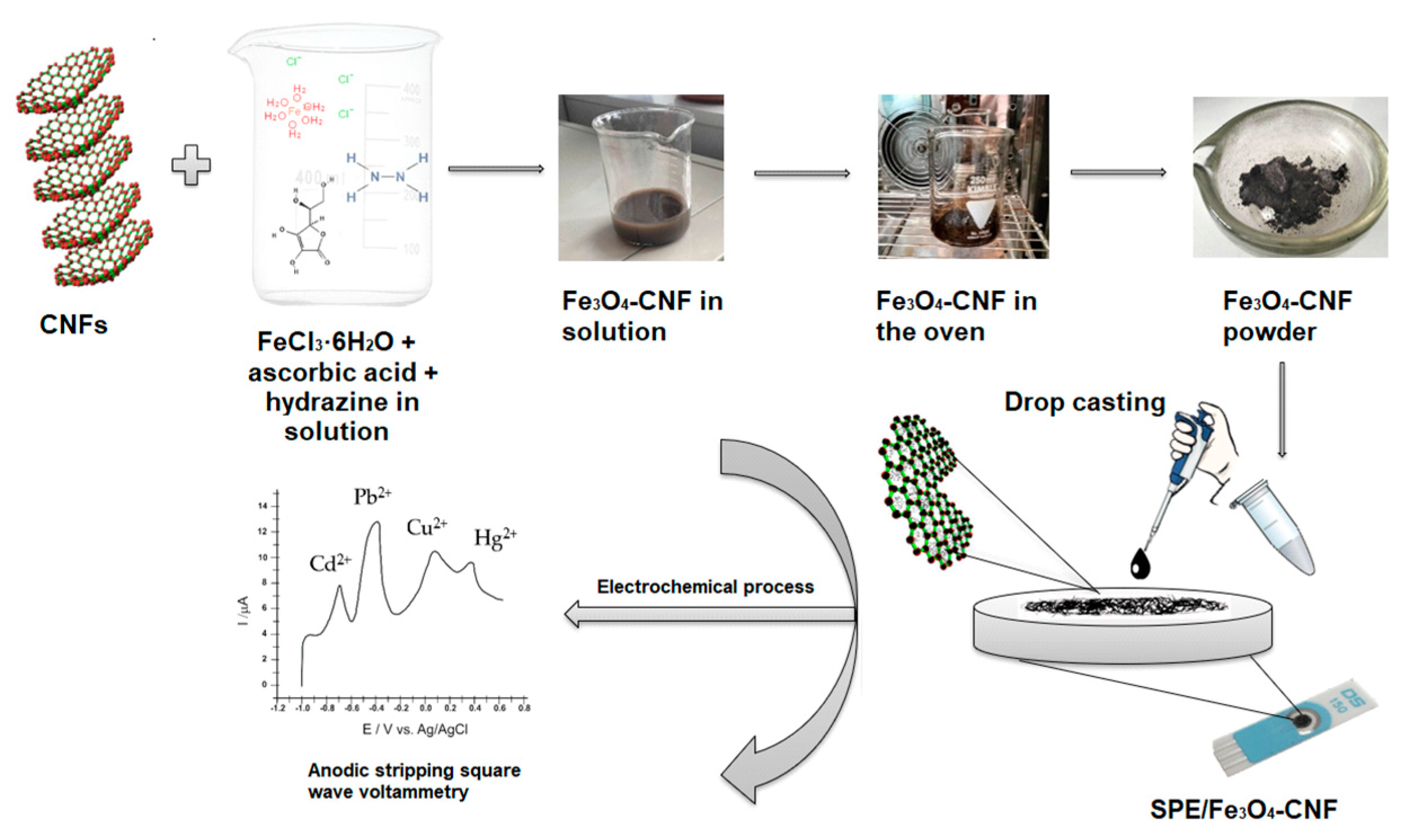


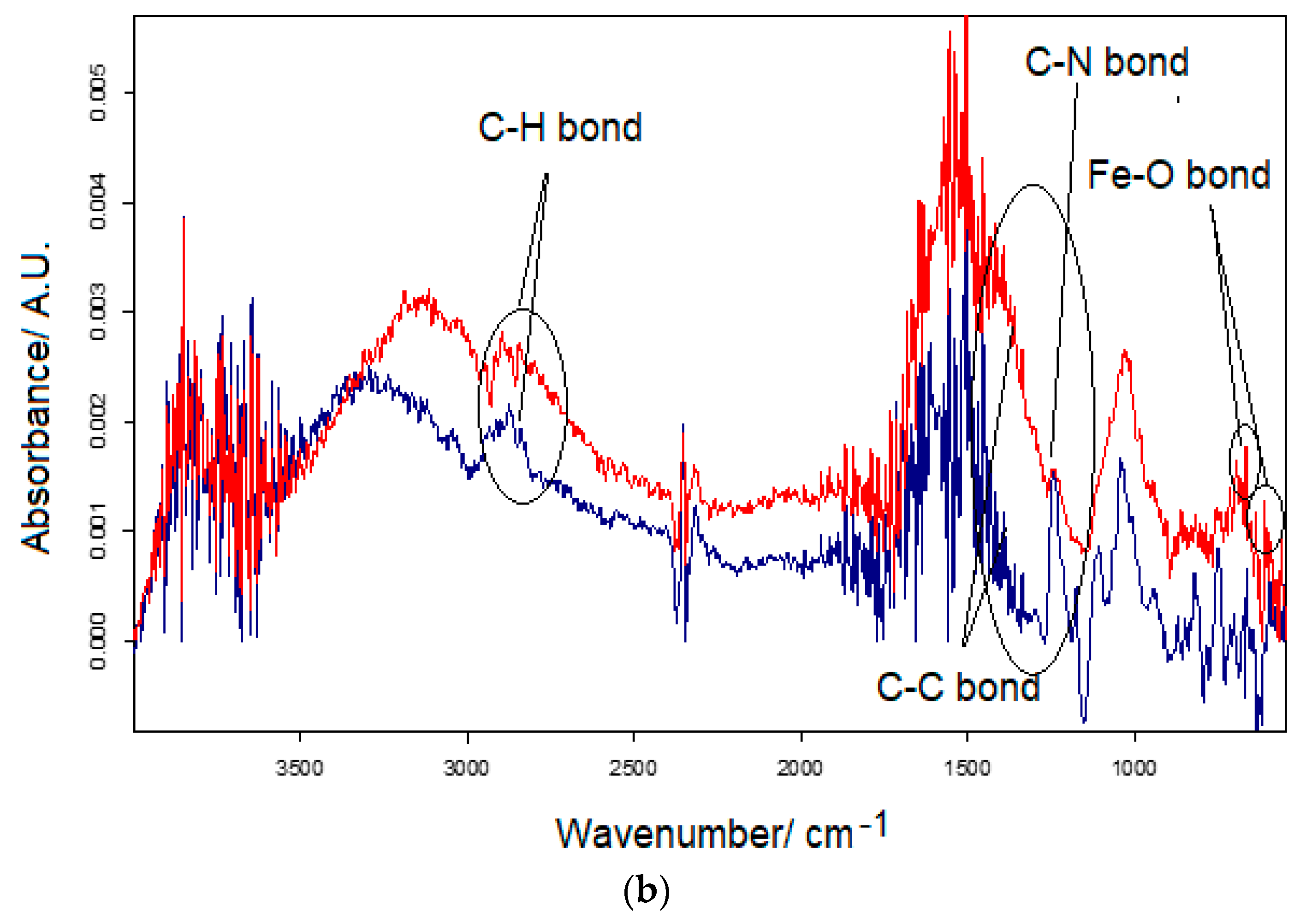
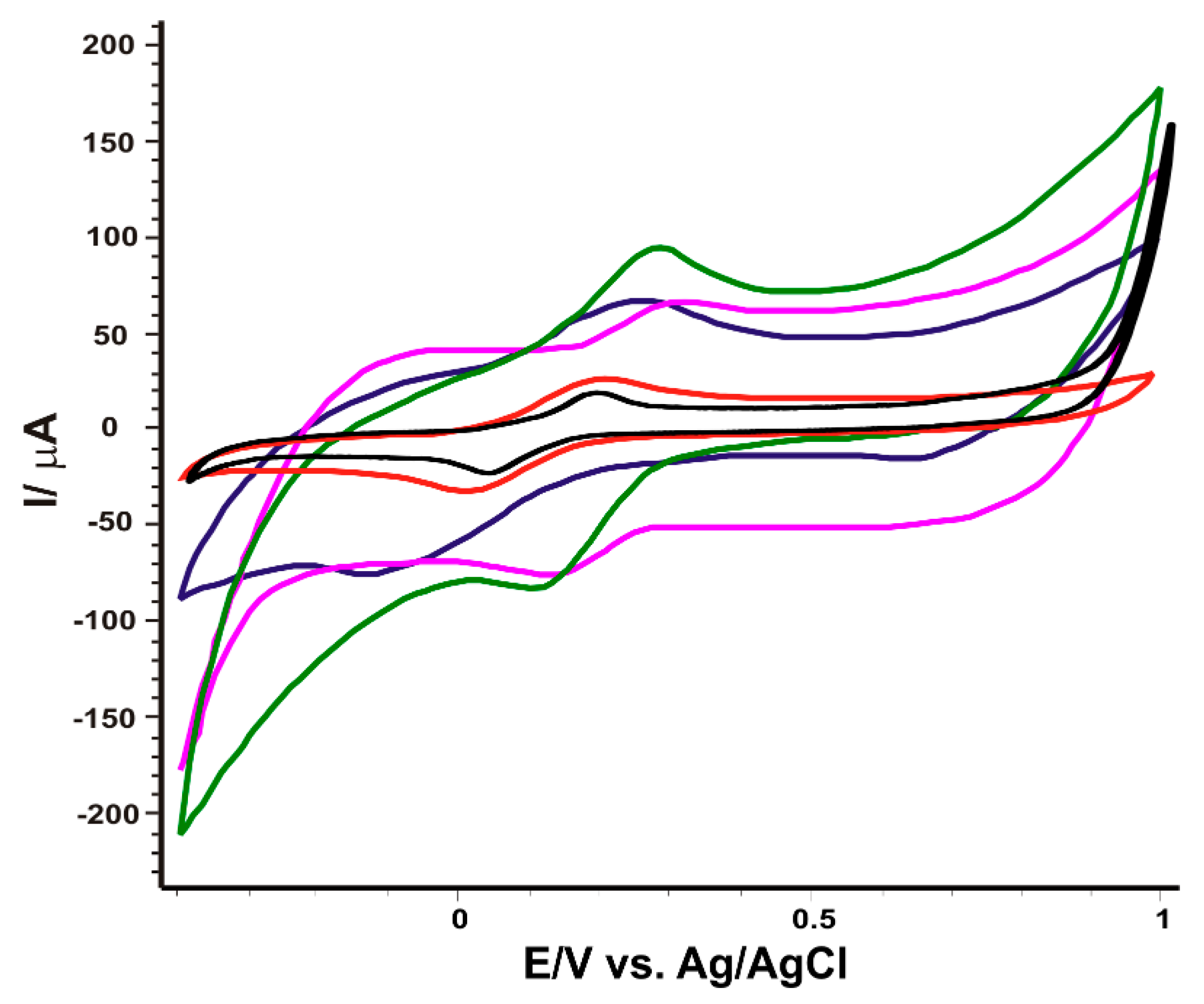
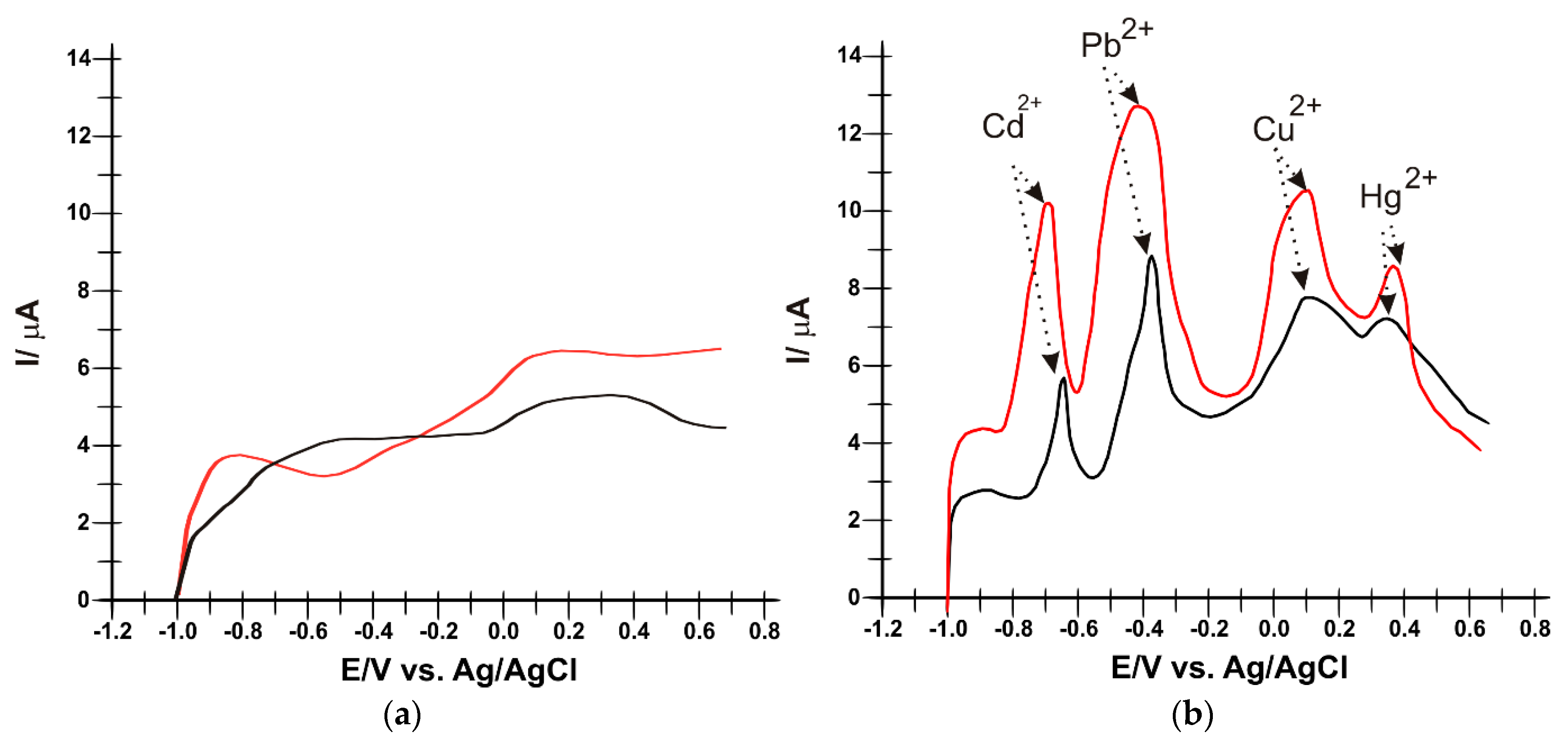
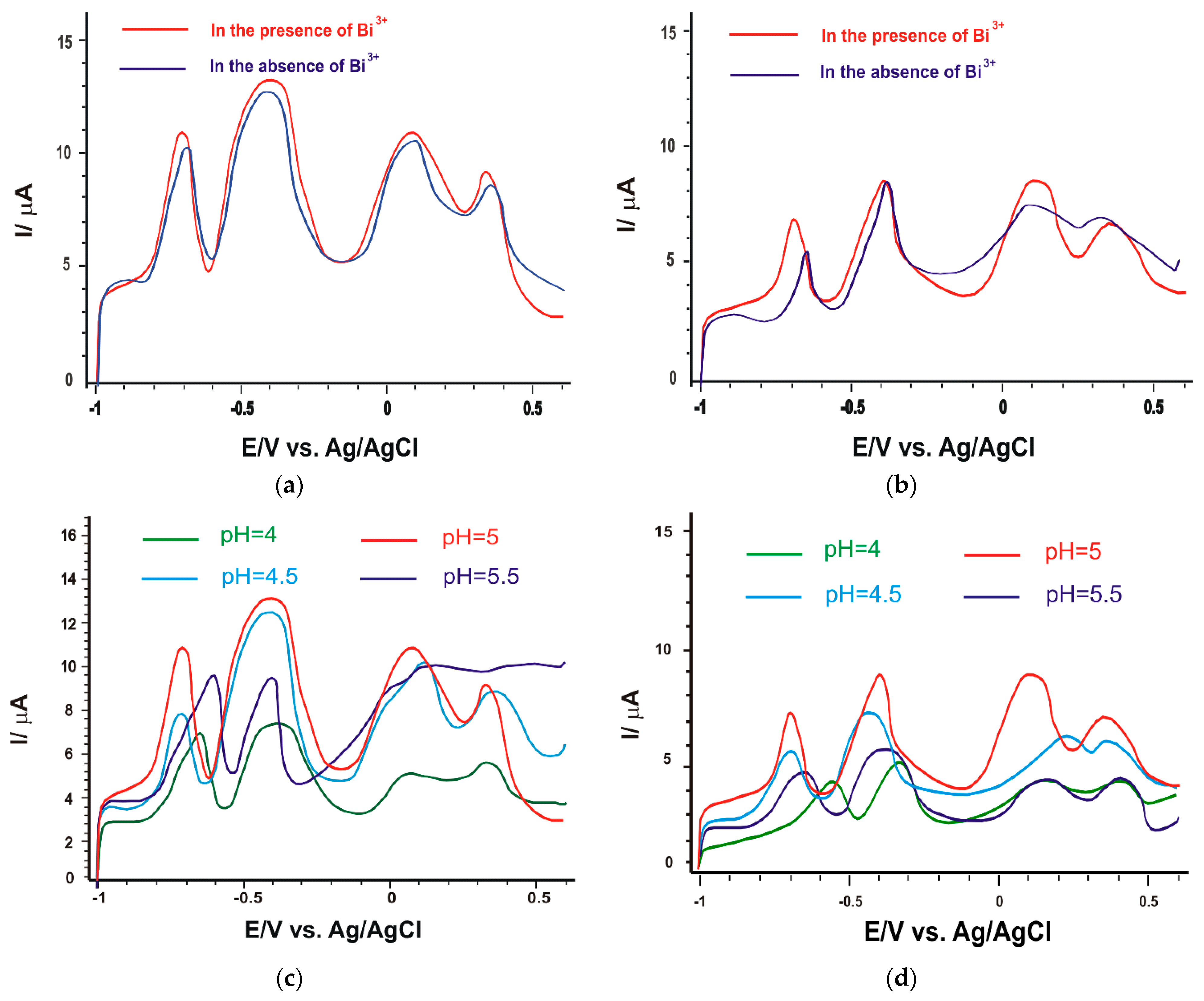


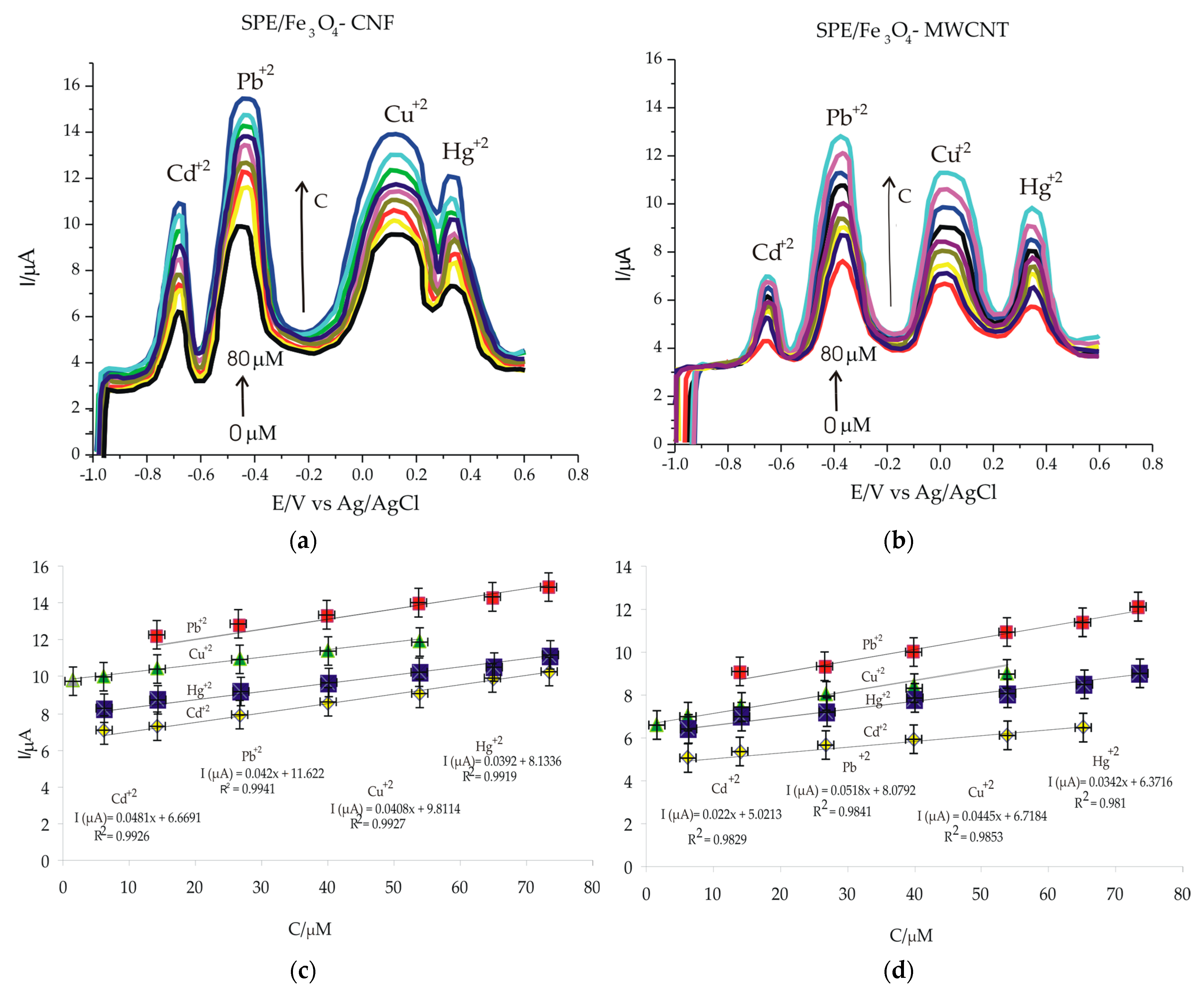

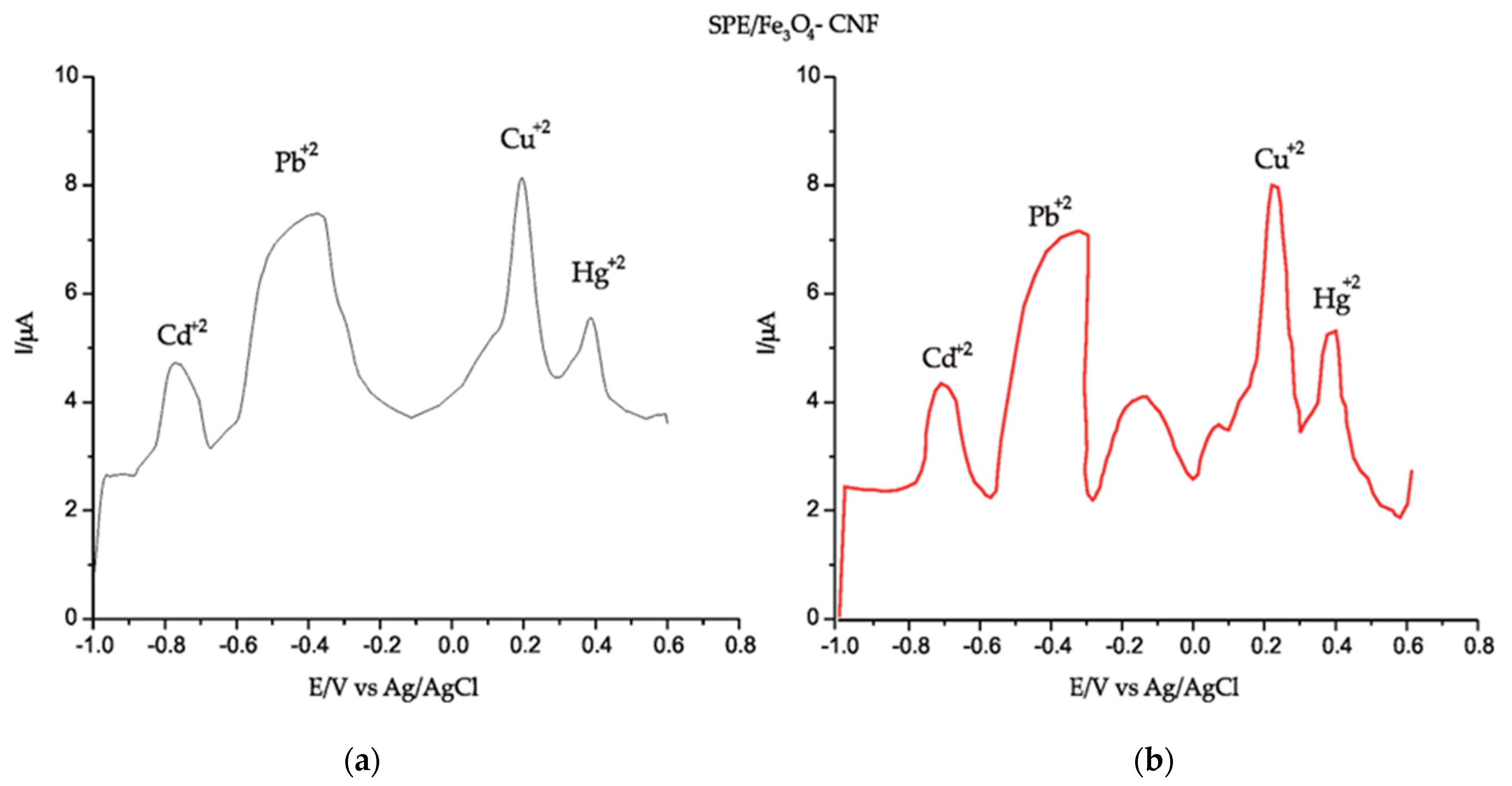
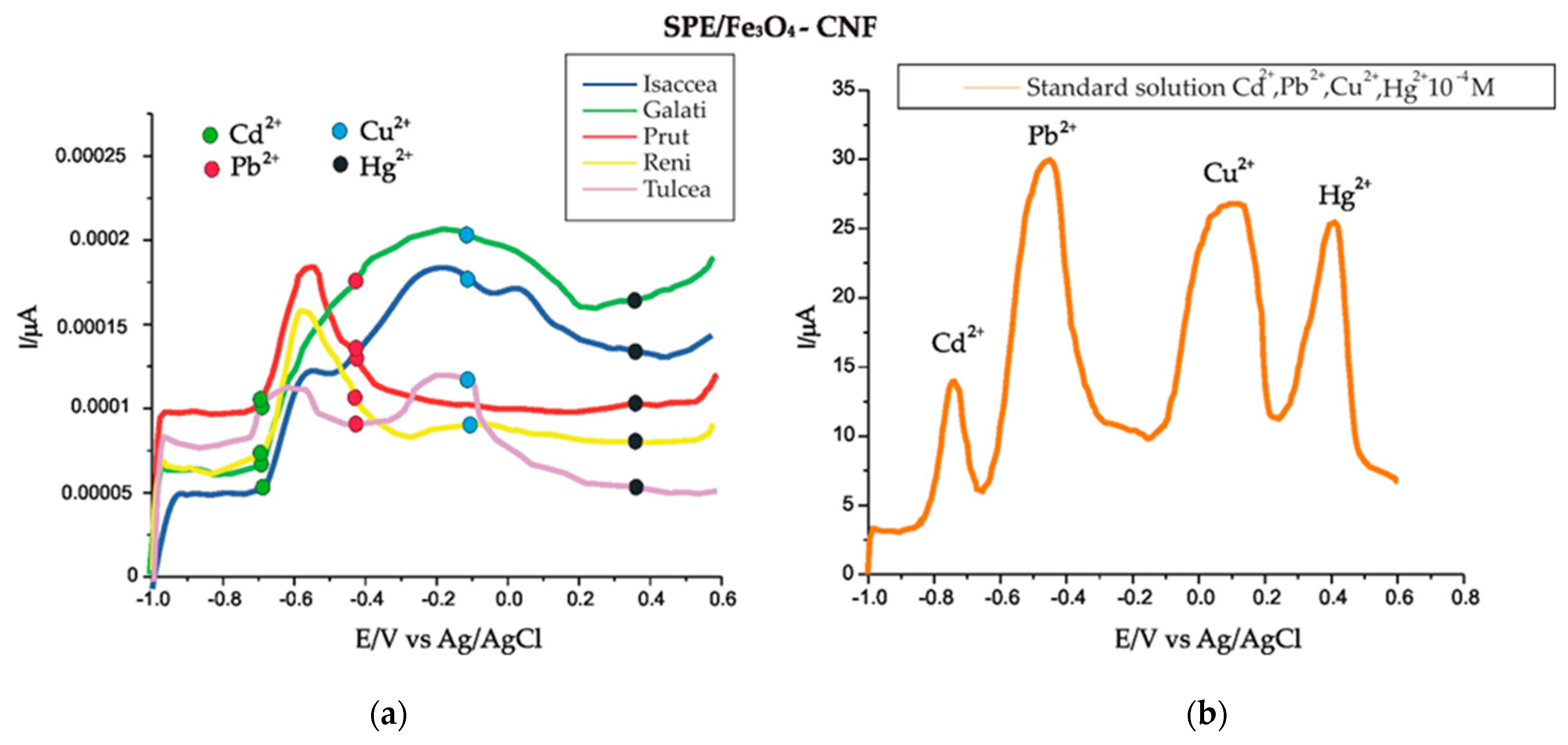
| Electrode | Epa 1 (V) | Epc 2 (V) | E1/2 3 (V) | Ipa 4 (µA) | Ipc 5 (µA) | ΔE 6 | Ipc/Ipa |
|---|---|---|---|---|---|---|---|
| SPE | 0.201 | 0.045 | 0.123 | 19.85 | −24.35 | 0.156 | 1.22 |
| SPE/CNF | 0.195 | 0.015 | 0.105 | 25.67 | −30.85 | 0.180 | 1.20 |
| SPE/MWCNT | 0.300 | 0.135 | 0.217 | 61.75 | −71.08 | 0.165 | 1.15 |
| SPE/Fe3O4-CNF | 0.274 | 0.126 | 0.200 | 94.11 | −83.89 | 0.148 | 0.89 |
| SPE/Fe3O4-MWCNT | 0.265 | −0.126 | 0.195 | 62.11 | −74.78 | 0.391 | 1.20 |
| Electrode | Linear Equation Ipa vs. v1/2 | R2 | Linear Equation log Ipa vs. log v | R2 | Points | Geometric Area (cm2) | Active Area (cm2) | Roughness Factor |
|---|---|---|---|---|---|---|---|---|
| SPE | I (A) = 6.64 × 10−5 v1/2 (V·s−1)1/2 + 4.61 × 10−6 | 0.9861 | log Ipa = 0.4614 log v − 4.1402 | 0.9865 | 5 | 0.125 | 0.032 | 0.25 |
| SPE/CNF | I (A) = 7.79 × 10−5 v1/2 (V·s−1)1/2 + 1.85 × 10−6 | 0.9972 | log Ipa = 0.4891log v − 4.0953 | 0.9975 | 0.039 | 0.31 | ||
| SPE/MWCNT | I (A) = 1.77 × 10−4 v1/2 (V·s−1)1/2 + 8.83 × 10−6 | 0.9893 | log Ipa = 0.4688log v − 3.7283 | 0.9905 | 0.086 | 0.69 | ||
| SPE/Fe3O4-CNF | I (A) = 5.43 × 10−4 v1/2 (V·s−1)1/2 + 7.78 × 10−5 | 0.9999 | log Ipa = 0.7341log v − 3.282 | 0.9972 | 0.265 | 2.12 | ||
| SPE/Fe3O4-MWCNT | I (A) = 3.72 × 10−4 v1/2 (V·s−1)1/2 + 5.35 × 10−5 | 0.9979 | log Ipa = 0.7524log v − 3.4367 | 0.9914 | 0.181 | 1.44 |
| Electrode | Metallic Ion | Epa (V) | Ipa (µA) |
|---|---|---|---|
| SPE/Fe3O4-CNF | Cd2+ | −0.696 | 10.150 |
| Pb2+ | −0.423 | 12.681 | |
| Cu2+ | 0.106 | 10.607 | |
| Hg2+ | 0.362 | 8.581 | |
| SPE/Fe3O4-MWCNT | Cd2+ | −0.648 | 5.545 |
| Pb2+ | −0.374 | 8.783 | |
| Cu2+ | 0.092 | 7.670 | |
| Hg2+ | 0.341 | 7.213 |
| σ (Standard Deviation) | ||||||||
|---|---|---|---|---|---|---|---|---|
| Sensor | Cd2+ | Pb2+ | Cu2+ | Hg2+ | ||||
| In Presence of Bi3+ | In Absence of Bi3+ | In Presence of Bi3+ | In Absence of Bi3+ | In Presence of Bi3+ | In Absence of Bi3+ | In Absence of Bi3+ | In Absence of Bi3+ | |
| SPE/Fe3O4-CNF | 0.00376 | 0.00646 | 0.00415 | 0.01870 | 0.00178 | 0.00719 | 0.00788 | 0.01036 |
| SPE/Fe3O4-MWCNT | 0.00618 | 0.01 | 0.00291 | 0.01045 | 0.00364 | 0.00828 | 0.00985 | 0.01848 |
| Electrode Material | Metal Ion | Method | Linear Range (μM) | LOD (μM) | LOQ (μM) | Reference |
|---|---|---|---|---|---|---|
| SPE/Fe3O4-CNF | Cd2+ | SWASV | 6–80 | 0.0615 | 0.2065 | In this study |
| Pb2+ | 14–80 | 0.0154 | 0.0514 | |||
| Cu2+ | 1–60 | 0.0320 | 0.1066 | |||
| Hg2+ | 6–80 | 0.0148 | 0.0493 | |||
| SPE/Fe3O4-MWCNT | Cd2+ | SWASV | 6–70 | 0.2719 | 0.9064 | In this study |
| Pb2+ | 14–80 | 0.3187 | 1.0623 | |||
| Cu2+ | 1–60 | 1.0436 | 3.4789 | |||
| Hg2+ | 6–80 | 0.9076 | 3.0256 | |||
| SnO2 modified electrode | Pb2+ | SWASV | 0.3–0.1 | 0.0104 | 0.0259 | [79] |
| Fe3O4-chitosan modified GCE (glassy carbon electrode) | Cd2+ | SWASV | 1.2–1.7 | 0.0392 | 0.1306 | [80] |
| Pb2+ | 0.1–1.4 | 0.0422 | 0.1406 | |||
| Cu2+ | 0.3–1.2 | 0.0967 | 0.3223 | |||
| Hg2+ | 0.4–1.2 | 0.0957 | 0.3191 | |||
| GCE/CN-polymer | Cd2+ | DPASV | 0.04–0.27 | 2.27 | 7.56 | [81] |
| Pb2+ | 0.002–0.15 | 0.8 | 2.66 | |||
| Fe3O4@SiO2 | Cd2+ | DPASV | 0.1–100 | 0.0561 | 0.1871 | [82] |
| Pb2+ | 0.1–80 | 0.0165 | 0.0550 | |||
| Cu2+ | 0.1–80 | 0.0794 | 0.2642 | |||
| Hg2+ | 0.1–100 | 0.0567 | 0.1891 |
| Metallic Ion | Cd2+ | Pb2+ | Cu2+ | Hg2+ | |
|---|---|---|---|---|---|
| Accuracy (RSD%) | Intra-day | 2.05 | 2.19 | 2.87 | 2.42 |
| Inter-day | 3.15 | 3.43 | 3.98 | 3.44 | |
| Reproducibility (RSD%) | 2.10 | 2.07 | 2.66 | 2.37 | |
| Sample | [Cd2+,Pb2+, Cu2+, Hg2+]/M | [Co2+,Ni2+, Mn2+, Zn2+]/M | [Cd2+,Pb2+, Cu2+, Hg2+]/M Found | Recovery (RSD) (%) |
|---|---|---|---|---|
| 1 | 2 × 10−4 | 2 × 10−4 | 2.01 × 10−4 | 100.50 ± 0.35 |
| 3 × 10−4 | 2 × 10−4 | 3.02 × 10−4 | 100.66 ± 0.47 | |
| 4 × 10−4 | 2 × 10−4 | 4.01 × 10−4 | 100.25 ± 0.17 | |
| 5 × 10−4 | 2 × 10−4 | 5.01 × 10−4 | 100.20 ± 0.14 | |
| 2 | 2 × 10−4 | 3 × 10−4 | 2.04 × 10−4 | 102.00 ± 1.4 |
| 3 × 10−4 | 3 × 10−4 | 2.98 × 10−4 | 99.33 ± 0.47 | |
| 4 × 10−4 | 3 × 10−4 | 3.99 × 10−4 | 99.75 ± 0.17 | |
| 5 × 10−4 | 3 × 10−4 | 5.03 × 10−4 | 100.60 ± 0.42 | |
| 3 | 2 × 10−4 | 4 × 10−4 | 2.02 × 10−4 | 101.00 ± 0.70 |
| 3 × 10−4 | 4 × 10−4 | 3.04 × 10−4 | 101.33 ± 0.93 | |
| 4 × 10−4 | 4 × 10−4 | 3.89 × 10−4 | 97.25 ± 1.97 | |
| 5 × 10−4 | 4 × 10−4 | 4.95 × 10−4 | 99.00 ± 0.71 | |
| 4 | 2 × 10−4 | 5 × 10−4 | 1.97 × 10−4 | 98.50 ± 1.06 |
| 3 × 10−4 | 5 × 10−4 | 3.06 × 10−4 | 102.00 ± 1.40 | |
| 4 × 10−4 | 5 × 10−4 | 3.95 × 10−4 | 98.75 ± 0.88 | |
| 5 × 10−4 | 5 × 10−4 | 5.01 × 10−4 | 100.20 ± 0.14 | |
| 5 | 2 × 10−4 | 6 × 10−4 | 2.03 × 10−4 | 101.50 ± 1.05 |
| 3 × 10−4 | 6 × 10−4 | 2.99 × 10−4 | 99.66 ± 0.23 | |
| 4 × 10−4 | 6 × 10−4 | 3.94 × 10−4 | 98.50 ± 1.06 | |
| 5 × 10−4 | 6 × 10−4 | 4.95 × 10−4 | 99.00 ± 0.71 |
| Metals | C (μg/L) | USEPA [83] (μg/L) | WHO [83] (μg/L) | ||||
|---|---|---|---|---|---|---|---|
| Isaccea | Galati | Prut | Reni | Tulcea | |||
| Cd2+ | 0.1171 | 0.1682 | 0.2360 | 0.1612 | 0.2827 | 5 | 3 |
| Pb2+ | 0.6314 | 0.8633 | 0.8880 | 0.5525 | 0.4045 | 15 | 10 |
| Cu2+ | 0.2337 | 0.2803 | 0.1541 | 0.1248 | 0.0967 | 1300 | 2000 |
| Hg2+ | 0.7061 | 0.8289 | 0.5219 | 0.3689 | 0.2568 | 2 | 1 |
| Sample | Cd2+ (μg/L) Initial | Cd2+ (μg/L) Added | Cd2+ (μg/L) Found | Recovery (%) |
|---|---|---|---|---|
| Isaccea | 0.1171 | 0.1 | 0.2221 | 102.30 ± 1.60 |
| 0.3 | 0.4061 | 97.36 ± 1.88 | ||
| 0.5 | 0.6211 | 100.64 ± 0.45 | ||
| Pb2+ (μg/L) Initial | Pb2+ (μg/L) Added | Pb2+ (μg/L) Found | Recovery (%) | |
| 0.6314 | 0.1 | 0.7421 | 101.46 ± 1.02 | |
| 0.3 | 0.9025 | 96.89 ± 2.22 | ||
| 0.5 | 1.122 | 99.17 ± 0.58 | ||
| Cu2+ (μg/L) Initial | Cu2+ (μg/L) Added | Cu2+ (μg/L) Found | Recovery (%) | |
| 0.2337 | 0.1 | 0.3451 | 103.41 ± 2.37 | |
| 0.3 | 0.5301 | 99.32 ± 0.47 | ||
| 0.5 | 0.7425 | 101.19 ± 084 | ||
| Hg2+ (μg/L) Initial | Hg2+ (μg/L) Added | Hg2+ (μg/L) Found | Recovery (%) | |
| 0.7061 | 0.1 | 0.825 | 102.34 ± 1.63 | |
| 0.3 | 1.026 | 101.97 ± 1.38 | ||
| 0.5 | 1.202 | 99.66 ± 0.24 |
Disclaimer/Publisher’s Note: The statements, opinions and data contained in all publications are solely those of the individual author(s) and contributor(s) and not of MDPI and/or the editor(s). MDPI and/or the editor(s) disclaim responsibility for any injury to people or property resulting from any ideas, methods, instructions or products referred to in the content. |
© 2024 by the authors. Licensee MDPI, Basel, Switzerland. This article is an open access article distributed under the terms and conditions of the Creative Commons Attribution (CC BY) license (https://creativecommons.org/licenses/by/4.0/).
Share and Cite
Dinu, A.; Bounegru, A.V.; Iticescu, C.; Georgescu, L.P.; Apetrei, C. Electrochemical Detection of Cd2+, Pb2+, Cu2+ and Hg2+ with Sensors Based on Carbonaceous Nanomaterials and Fe3O4 Nanoparticles. Nanomaterials 2024, 14, 702. https://doi.org/10.3390/nano14080702
Dinu A, Bounegru AV, Iticescu C, Georgescu LP, Apetrei C. Electrochemical Detection of Cd2+, Pb2+, Cu2+ and Hg2+ with Sensors Based on Carbonaceous Nanomaterials and Fe3O4 Nanoparticles. Nanomaterials. 2024; 14(8):702. https://doi.org/10.3390/nano14080702
Chicago/Turabian StyleDinu (Iacob), Ancuța, Alexandra Virginia Bounegru, Catalina Iticescu, Lucian P. Georgescu, and Constantin Apetrei. 2024. "Electrochemical Detection of Cd2+, Pb2+, Cu2+ and Hg2+ with Sensors Based on Carbonaceous Nanomaterials and Fe3O4 Nanoparticles" Nanomaterials 14, no. 8: 702. https://doi.org/10.3390/nano14080702







